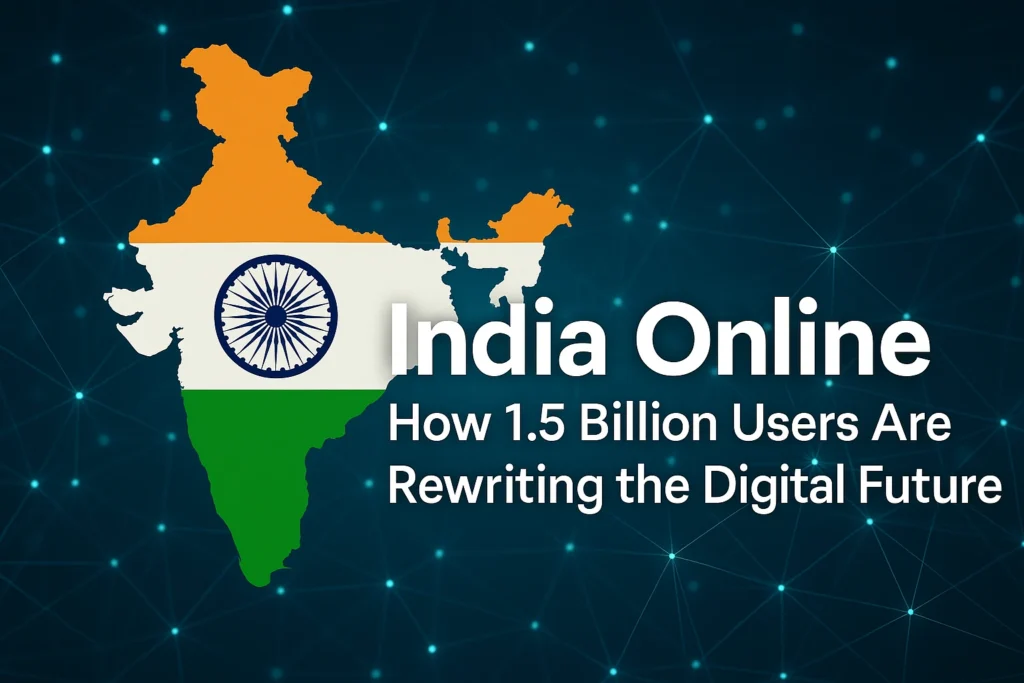For decades, the global digital landscape was dominated by tech giants and vast user bases in Western nations and China. Yet, a silent, monumental shift has been underway, driven by the sheer scale and unique characteristics of one nation: India. With nearly a billion people now connected, India is not just rapidly expanding its online population; it’s fundamentally reshaping how the world thinks about internet access, digital consumption, and the very future of the digital economy. It’s a story of unprecedented growth, powered by affordable mobile technology, ambitious government initiatives, and a burgeoning desire for local, accessible digital experiences that are bringing connectivity to every corner of the vast subcontinent.
Once trailing behind in internet penetration, India has surged forward, now holding the position of the second-largest internet user base globally, rapidly closing in on the top spot and having already far surpassed nations like the United States. This isn’t merely about numbers; it’s about a profound societal transformation where digital tools are empowering individuals, catalyzing economic growth, and fostering innovation on an unimaginable scale.
A Billion Dreams Connected: The Scale of India’s Online Population
To truly grasp India’s digital ascendancy, one must look at the numbers. As of early 2024, India’s active internet user base stood at an astounding 886 million people, a robust 8% year-on-year growth. Projections indicate that this number is set to cross 900 million by 2025. To put this in perspective, while China currently leads with over 1.1 billion internet users, India’s growth trajectory is significantly steeper. The United States, by comparison, stands at approximately 311.3 million users. This places India firmly as the second-largest internet user nation worldwide, a remarkable achievement that underscores its immense potential.
This isn’t a static snapshot; it’s a dynamic, ever-expanding network. Each year, tens of millions of new users come online in India, many of them experiencing the internet for the very first time. This massive influx is not just adding to a tally; it’s diversifying the internet’s demographic, bringing new perspectives, new needs, and new forms of digital engagement that are unique to the Indian context. It’s a digital ecosystem rapidly evolving to meet the demands of nearly one-fifth of the global online population.
The Mobile Revolution: Internet in Every Pocket
The story of India’s internet explosion cannot be told without highlighting the pivotal role of the mobile phone. Unlike many developed nations where internet access first took root through desktop computers and broadband lines, India’s digital journey has been overwhelmingly mobile-first. For the vast majority of Indian users, their smartphone isn’t just one way to access the internet; it’s the only way.
This shift was dramatically accelerated by a phenomenon often referred to as the “Jio effect.” In 2016, the entry of Reliance Jio into the telecom market with incredibly affordable 4G data plans and even free voice calls sparked a massive price war. Before Jio, the cost of 1GB of mobile data could be as high as ₹225 (approximately $3). Within a few years, this plummeted to under ₹10 (around $0.12) per GB. This unprecedented affordability, combined with increasingly budget-friendly smartphones, effectively democratized internet access, putting the power of connectivity into the hands of hundreds of millions who previously couldn’t afford it.
The impact was immediate and profound. India swiftly became the world’s largest consumer of mobile data. This mobile-first approach means that digital services, applications, and content are predominantly designed for smartphone screens, often optimized for lower bandwidths and diverse local languages. It’s not just about affordability, but about accessibility and convenience, transforming the smartphone into a powerful gateway to information, entertainment, and economic opportunities for a vast and diverse population.
Beyond the Cities: Rural India’s Digital Awakening
One of the most transformative aspects of India’s internet growth is its deep penetration into rural areas. For years, the digital divide between urban and rural India was stark, with connectivity largely concentrated in major cities. However, this gap is not just narrowing; rural India is now leading the charge in terms of user growth.
According to the “Internet in India 2024” report by the Internet and Mobile Association of India (IAMAI) and Kantar, rural India, with 488 million users, now accounts for over 55% of the total internet population. This means that more internet users reside in India’s villages and smaller towns than in its bustling metropolises. This remarkable expansion has been fueled by:
- Government Initiatives: Programs like BharatNet (previously the National Optical Fibre Network) have been instrumental in laying down optical fiber cable infrastructure to connect Gram Panchayats (village councils) across the country. As of early 2025, over 2.18 lakh Gram Panchayats have been connected, bringing high-speed internet closer to rural homes.
- Common Service Centres (CSCs): These are physical centers, often run by local entrepreneurs, that provide digital services to rural citizens who may not own a smartphone or possess the necessary digital literacy. They act as vital hubs, offering everything from bill payments and government services to online education and financial inclusion.
- Increased Mobile Tower Coverage: Driven by both government mandates and private telecom expansion, mobile network coverage, particularly 4G, has reached over 6.14 lakh villages as of late 2024, ensuring that even remote communities can connect.
This rural awakening is not just about access; it’s about empowerment. Farmers are getting real-time weather forecasts and market prices, students in remote villages are accessing online education, and small businesses are finding new customers beyond their local markets. The internet is truly becoming a utility, much like electricity or water, reshaping lives in India’s heartland.
Local Languages, Global Reach: Content Driving Consumption
For internet adoption to truly flourish in a country as linguistically diverse as India, content needs to speak the users’ language. And in India, this has been a critical driver of growth. The internet is no longer a domain primarily for English speakers.
The IAMAI-Kantar report highlights that nearly all internet users (98%) accessed content in Indic languages in 2024. This is a powerful testament to the demand for local language content. Regional languages like Tamil, Telugu, and Malayalam have emerged as highly popular due to the extensive availability of content in these scripts. Even among urban internet users, over half (about 57%) prefer consuming content in regional languages.
This surge in Indic language content has been spurred by:
- Localized Apps and Platforms: Digital platforms, from social media giants to e-commerce players, have invested heavily in creating interfaces and content in multiple Indian languages, making them more intuitive and engaging for non-English speakers.
- Voice Search and AI: The increasing prevalence of voice-enabled search and AI assistants that understand Indian accents and languages has lowered the barrier to entry for users who may not be comfortable typing in English.
- Regional Content Creators: A vibrant ecosystem of local content creators, influencers, and news outlets has emerged, producing videos, articles, and entertainment specifically tailored to regional audiences.
This linguistic inclusivity is crucial. It means that the internet is not just a tool for the elite but a truly democratic space where information and entertainment are accessible to everyone, regardless of their proficiency in English. It ensures that the digital revolution is deeply rooted in India’s cultural fabric, fostering a more inclusive and vibrant online ecosystem.
The Digital Economy Boom: What Nearly A Billion Users Do Online
With hundreds of millions of users coming online, India’s digital landscape is not just about connectivity; it’s about vibrant economic activity. The burgeoning user base is powering a digital economy that is growing at an incredible pace, contributing significantly to the nation’s GDP.
India’s digital economy is projected to contribute nearly one-fifth of the national income by 2029-30, potentially surpassing the share of traditional sectors like agriculture or manufacturing. This explosive growth is driven by several key areas:
- Digital Payments (UPI): India’s Unified Payments Interface (UPI) has revolutionized financial transactions. It’s an instant real-time payment system that has become the backbone of India’s digital economy, making cashless transactions commonplace even in the smallest villages. In April 2025 alone, over 18.6 billion transactions worth ₹24.77 lakh crore (approximately $297 billion) were processed through UPI. This has positioned India as a global leader in real-time digital payments.
- E-commerce: Online shopping has moved beyond urban centers. The rapid growth of rural internet users and the proliferation of local language content have opened up vast new markets for e-commerce platforms. Businesses, both large and small, are leveraging online channels to reach customers nationwide, driving the growth of both traditional e-tailers and innovative omni-channel models.
- Online Education: The digital realm has democratized access to learning. Platforms like DIKSHA and SWAYAM, along with numerous private ed-tech companies, offer online courses, e-books, and even virtual classrooms, breaking geographical barriers for students, particularly in remote areas.
- Entertainment and Social Media: Streaming services for video and music, as well as social media platforms, dominate online engagement. Rural users, in particular, show high engagement in these categories, outpacing urban users in some aspects of OTT video and music streaming. This rich content consumption fuels the advertising and content creation industries.
- Digital Public Infrastructure (DPI): Beyond individual apps, India has built a robust DPI stack, including Aadhaar (digital identity), DigiLocker (digital document wallet), and UMANG (unified app for government services). These foundational digital platforms simplify access to services, enhance transparency, and drive widespread digital adoption.
This dynamic digital economy is creating millions of jobs, fostering a vibrant startup ecosystem, and enabling millions of Indians to participate in the global digital future, directly from their smartphones.
Government as Catalyst: The ‘Digital India’ Vision
The incredible pace of India’s digital transformation is not accidental; it is underpinned by a strategic national vision: the “Digital India” mission, launched by the Government of India in 2015. This flagship initiative aims to transform India into a digitally empowered society and a knowledge-based economy.
The mission is built on several pillars, all working in concert to create an enabling digital ecosystem:
- Broadband Highways: The ambitious BharatNet project, as mentioned earlier, is a cornerstone, aiming to provide high-speed broadband connectivity to all villages. This is the physical backbone enabling digital services to reach the remotest corners.
- Universal Access to Mobile Connectivity: Continuous efforts are made to extend mobile network coverage to currently uncovered villages, ensuring that no community is left behind.
- Public Internet Access Programme: The establishment and expansion of Common Service Centres (CSCs) have created crucial physical touchpoints, offering digital services to citizens who may lack personal devices or digital literacy.
- e-Governance: This pillar focuses on making government services available digitally, enhancing efficiency, transparency, and reducing corruption. Platforms like UMANG provide a single point of access to numerous government services across various departments in multiple Indian languages.
- Digital Literacy: Programs like Pradhan Mantri Gramin Digital Saksharta Abhiyan (PMGDISHA) aim to make rural households digitally literate, equipping citizens with the basic skills needed to navigate the online world.
- Electronics Manufacturing: The government is also promoting indigenous electronics manufacturing to reduce dependency on imports and foster a self-reliant digital economy.
The impact of Digital India is visible in everyday life, from instant digital payments via UPI to seamless access to government documents through DigiLocker. These initiatives have not only boosted connectivity but have also streamlined governance, improved service delivery, and fostered a culture of digital adoption across the country, fundamentally reshaping the interaction between citizens and the state.
Navigating the Challenges: Speed Bumps on the Digital Highway
Despite its remarkable progress, India’s digital journey is not without its challenges. Addressing these hurdles is crucial for sustaining growth and ensuring true digital inclusion for all its citizens.
- Bridging the Last-Mile Digital Divide: While connectivity has expanded significantly, issues like inconsistent internet speed and quality persist in many remote and geographically challenging areas. Laying fiber optic cables across diverse terrains and ensuring reliable power supply for infrastructure remain significant logistical and financial undertakings.
- Digital Literacy Gap: While internet penetration is high, a significant portion of the population, particularly in rural areas and among older demographics, still lacks advanced digital literacy skills. This can limit their ability to fully leverage online services beyond basic communication or entertainment. Government programs are working on this, but it’s a continuous effort.
- Gender Disparity: Although the digital gender gap is steadily narrowing (with 47% of all internet users being women in 2024, the highest ever), disparities still exist, especially in shared device usage in rural households where women often rely on family members’ phones.
- Affordability Beyond Data: While data plans are cheap, the cost of smartphones themselves can still be a barrier for the poorest segments of the population.
- Cybersecurity and Data Privacy: As more aspects of life move online, protecting user data and ensuring cybersecurity become paramount concerns. Educating users about online safety and building robust digital infrastructure to combat threats are ongoing priorities.
- Quality of Content and Misinformation: The rapid growth of online content also brings challenges related to the quality of information and the spread of misinformation, particularly in regional languages.
Overcoming these challenges requires continuous investment in infrastructure, innovative policy-making, concerted efforts in digital education, and a strong focus on user protection.
The Road Ahead: India’s Digital Future
The trajectory of India’s digital future points towards continued, exponential growth. Projections suggest that India will not only solidify its position as the second-largest internet user base but will also deepen its digital penetration across all segments of society.
The next wave of growth is expected to be driven by:
- 5G Expansion: The rapid rollout of 5G services across India, with 5G now covering nearly all districts, promises even faster speeds and lower latency, enabling new applications and richer digital experiences, from advanced telemedicine to immersive online education.
- Artificial Intelligence (AI) and Machine Learning (ML): AI is set to further personalize digital experiences, enhance productivity, and enable more sophisticated services in areas like customer support, healthcare diagnostics, and financial advisory, often delivered through voice interfaces.
- Deeper Sectoral Digitalization: While some sectors like payments have seen massive digital adoption, others like healthcare, education, and even retail (beyond e-commerce) are poised for deeper digitalization. This includes everything from digital health records and online consultations to smart classrooms and hyper-localized digital commerce.
- The Creator Economy: With more users online and a growing appetite for local content, India’s vibrant creator economy is set to boom, providing new avenues for employment and cultural expression.
- Global Digital Influence: India’s unique model of digital public infrastructure (the “India Stack”) is gaining international recognition, with several countries exploring its adoption. This positions India as a thought leader in building inclusive and scalable digital ecosystems for developing nations.
India’s digital journey is a testament to the power of connectivity and innovation. It showcases how a nation can leverage technology to empower its vast population, drive economic growth, and address societal challenges at an unprecedented scale.
Conclusion: A Connected India, A Transformed World
The sheer scale of India’s internet user base – now nearing a billion and still growing – is not merely a statistical marvel; it’s a testament to a profound digital awakening that is reshaping the nation from its bustling urban centers to its remotest villages. Driven by affordable mobile data, a mobile-first approach, and a strategic vision articulated through initiatives like “Digital India,” the country has transformed from a digitally underserved nation into a global powerhouse of internet consumption and digital innovation.
This widespread connectivity is fueling a vibrant digital economy, enabling seamless payments, expanding access to education and healthcare, and empowering individuals with information and opportunities previously unimaginable. While challenges such as ensuring universal quality access and bridging lingering digital literacy gaps remain, India’s trajectory is clear. The nation’s unique model of digital growth, characterized by its emphasis on mobile-first, local languages, and inclusive public infrastructure, offers valuable lessons for the rest of the world.
As India continues its digital ascent, every new user, every online transaction, and every piece of localized content contributes to rewriting the global digital future. It’s a future where nearly a billion connected Indians are not just passive consumers but active participants, innovators, and drivers of a truly global and inclusive digital age.




gjf9sp